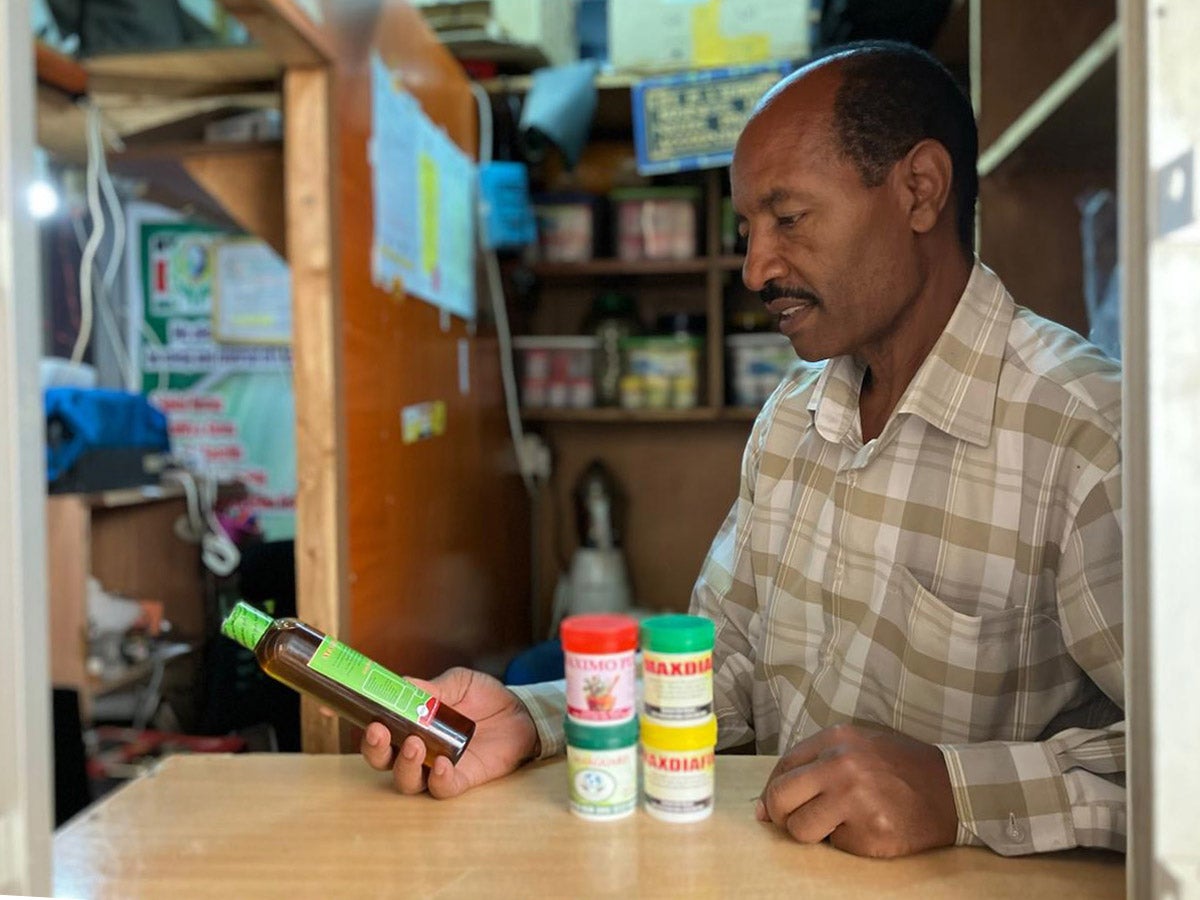
Feature
Cambodia’s new path for prosthetic care
As a girl growing up near Phnom Penh, Sisary Kheng wanted to be a pediatrician, but her family couldn’t afford to send her to medical school. She became a prosthetist instead, an important role in Cambodia, which in the mid-1990s had millions of landmines, unexploded bombs, and other munitions strewn across its countryside. Now, she is playing a central role in Cambodia’s latest effort to stand on its own when it comes to providing care for victims of unexploded ordnance.
“We cannot rely on international aid anymore,” says Kheng, 44, Cambodia country director of Exceed Worldwide, an NGO that provides prosthetics and rehabilitation services. “Government ownership of the process and its success is very important.”
Sign up for Harvard Public Health
Delivered to your inbox weekly.
In 1996, when Kheng started her training, prosthetics and rehabilitation for survivors had been paid for and provided almost exclusively by NGOs for nearly 15 years. She’s working on a doctorate developing models for how Cambodia can sustainably self-fund the services.
Her work comes at a crucial time for the country, where rehabilitation services could face severe challenges in the next few years if funding models don’t change. Since the 1980s, Cambodia has received hundreds of millions of dollars in support of mine removal from NGOs and international governments. But assistance for victims of landmines often lags behind—and lately, concentrates in very few countries. In 2022, half of all victim assistance support went to just three countries: Afghanistan, Syria, and Yemen. There were 34 other countries with landmine victims; only seven received dedicated help for victims assistance, while in five others, including Cambodia, victims were supported through broader programs.

Sisary Kheng, country director of Exceed Worldwide, does the rounds at the Faculty of Prosthetic and Orthotic Engineering at the National Institute of Social Affairs in Phnom Penh, Cambodia.
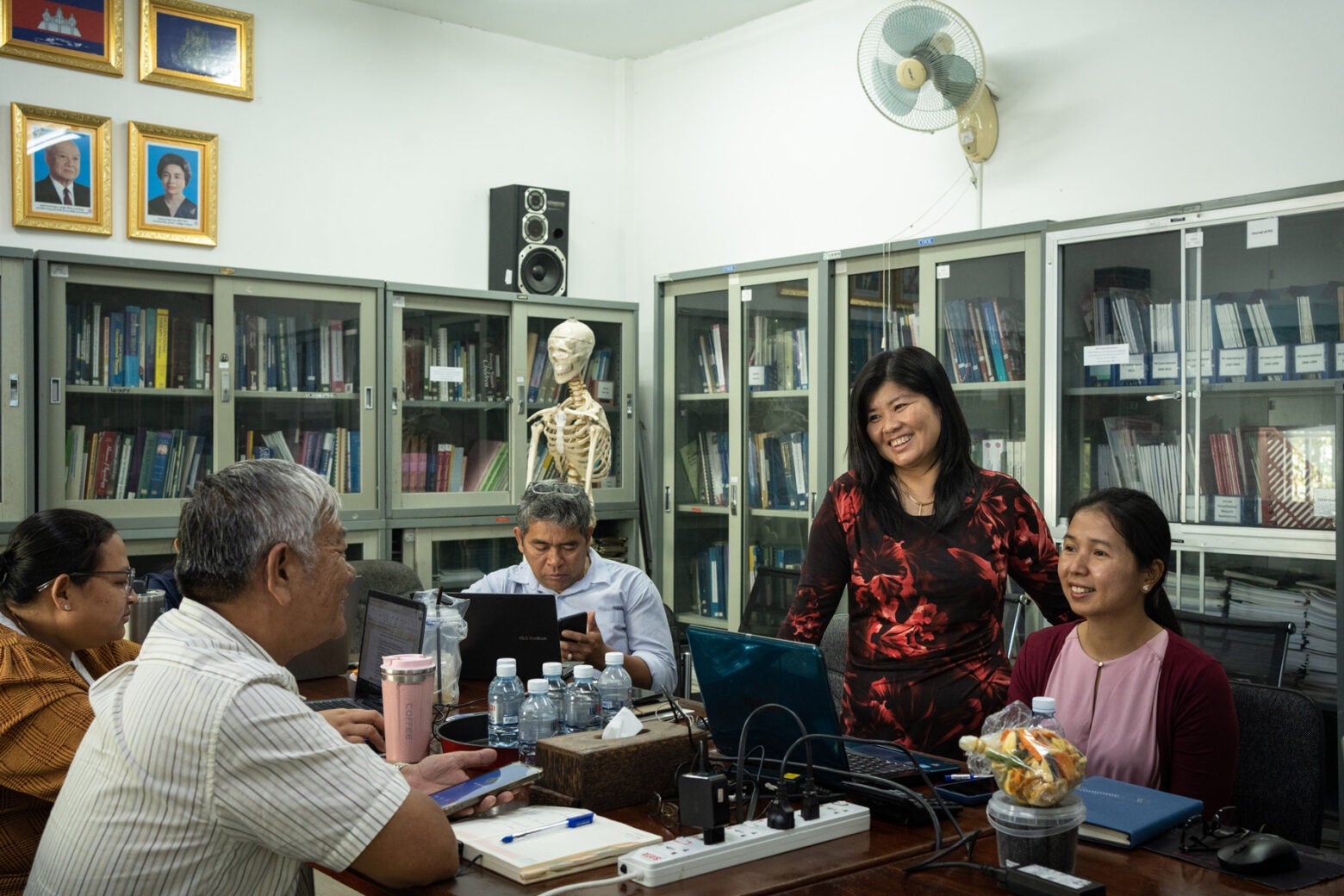
Kheng during a budget meeting for Cambodia's branch of Exceed Worldwide.
“It’s getting more and more difficult to chase down donor funds,” says Carson Harte, CEO of Exceed Worldwide Group, which began supplying prosthetics in Cambodia in 1992. (A year later, it started the school in Phnom Penh where Kheng became one of the country’s first female prosthetists.) Exceed only avoided layoffs last year thanks to a “MrBeast” fundraising video on YouTube.
Cambodia has tried before to wean its prosthetics services off donor and NGO support. In 2012, its Ministry of Social Affairs, Veterans and Youth Rehabilitation (MoSVY) began providing services to people with disabilities. Based on data reported in a 2022 study by NGOs and the government, obtained by Harvard Public Health, this effort seems to have largely failed.
MoSVY operated five of the country’s 11 physical rehabilitation facilities, with funding from the Persons with Disabilities Foundation. The other six were operated and supported by Exceed, the International Committee of the Red Cross, and Handicap International. The collaborative study found that staff, services, and morale suffered in centers run by MoSVY. It also said international NGOs remain responsible for more than 77 percent of prosthetics or orthoptist services and more than 83 percent of wheelchair services.
The report recommended that prosthetic services be placed under the Ministry of Health and embedded in a nascent universal health care system being developed with the World Health Organization. The Ministry of Health’s financial reforms and improvements in health services were praised in a letter from Yohei Sasakawa, CEO of the Nippon Foundation, a significant funder of landmine relief. He wrote that such a shift “will greatly improve sustainability and staff retention and will reduce costs.”
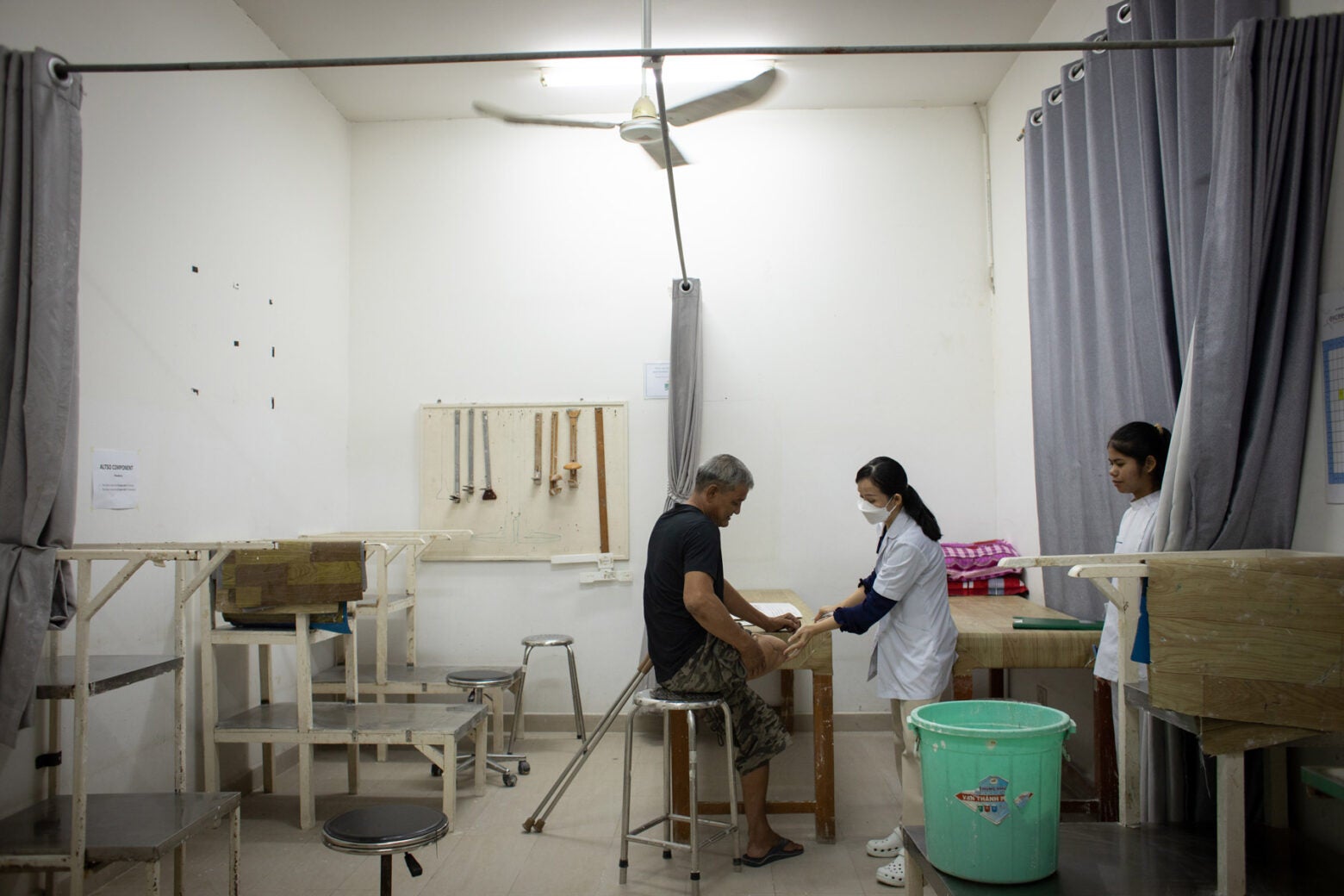
A patient injured by a landmine gets a checkup at Exceed Worldwide in Phnom Penh. Prosthetic care in Cambodia initially focused on landmine injuries. Now, traffic accidents and diabetes are the cause of an increasing number of cases.
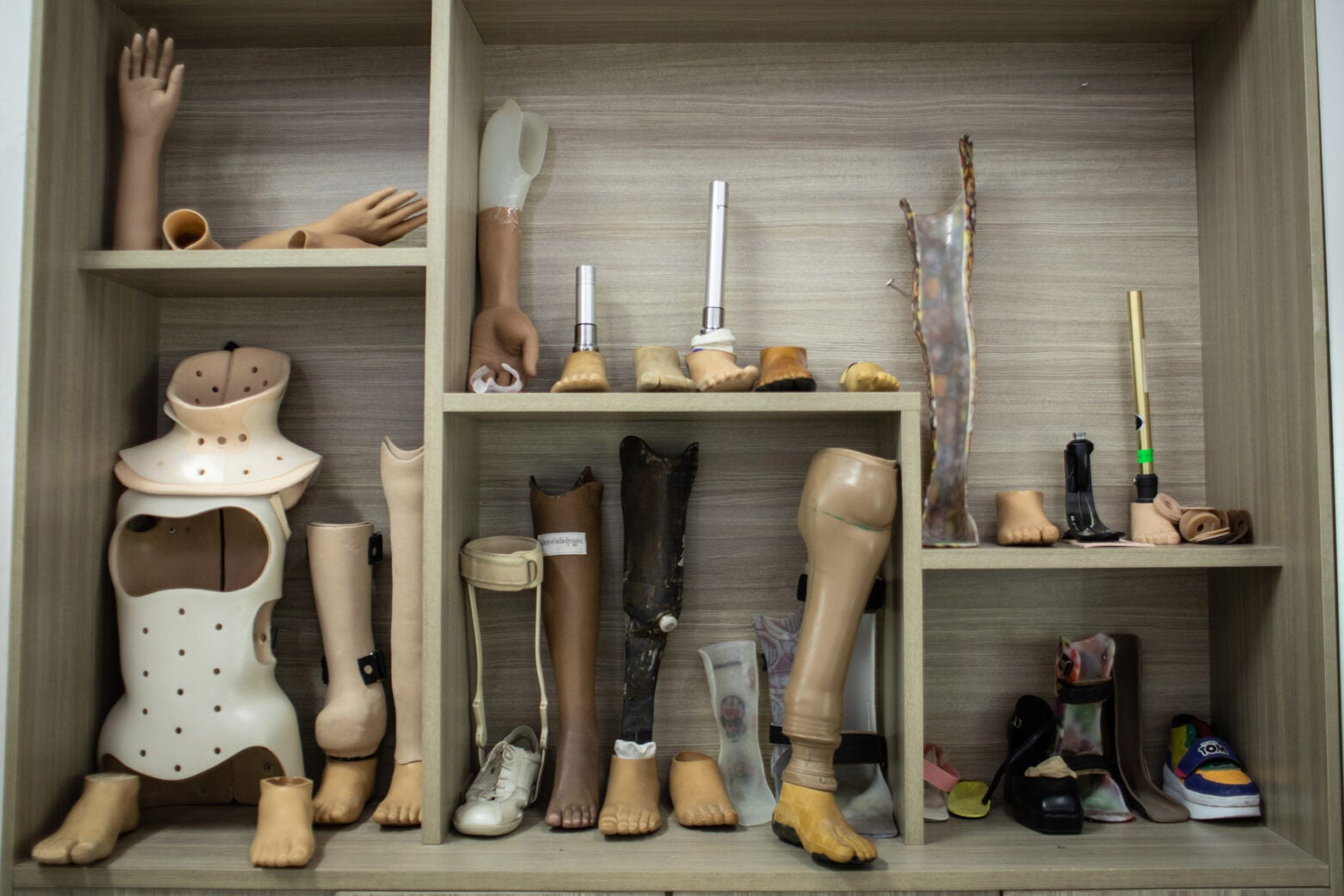
A display of prosthetic limbs at Exceed Worldwide's Modern Services Clinic in Phnom Penh. The private clinic serves patients who would otherwise have to seek higher-end prosthetics in neighboring countries.
Under the proposed model, basic care will be covered by public health funds, but higher-end prosthetics would be paid for by patients, with any profits funneled back into subsidizing prosthetic services. Exceed has already been trialing the approach at a clinic attached to its school, which provides advanced artificial limbs.
Kheng says the model would help retain staff and capture money that would otherwise be spent in more advanced countries like Singapore, where patients with means often seek high-end prosthetics. It would also make care more accessible by integrating it into hospitals and clinics. This would help survivors of landmines and unexploded ordnance as well as a growing number of road accident victims and patients with medical conditions like diabetes. “Every dollar you invest in people with disabilities, through rehabilitation you can actually get nine dollars out of your investment because they can do something else,” Kheng says, citing a recent estimate from the International Disability Alliance.
That’s certainly been true for Lim Eng. She stepped on a landmine in 1982 while working with a team clearing Pich Nil mountain, in the southwest of the country. She still cries as she describes the experience, and then finding out she would lose the lower part of her right leg. “I wanted to die,” says Eng, who is now 65, speaking in Khmer. But after being treated and relearning how to ride a bicycle, “It made me feel like I could live,” she says.
She now works at Exceed, where she is part of a community development team that works in Phnom Penh and its outskirts, informing people about available services and breaking down the stigma surrounding disabilities.
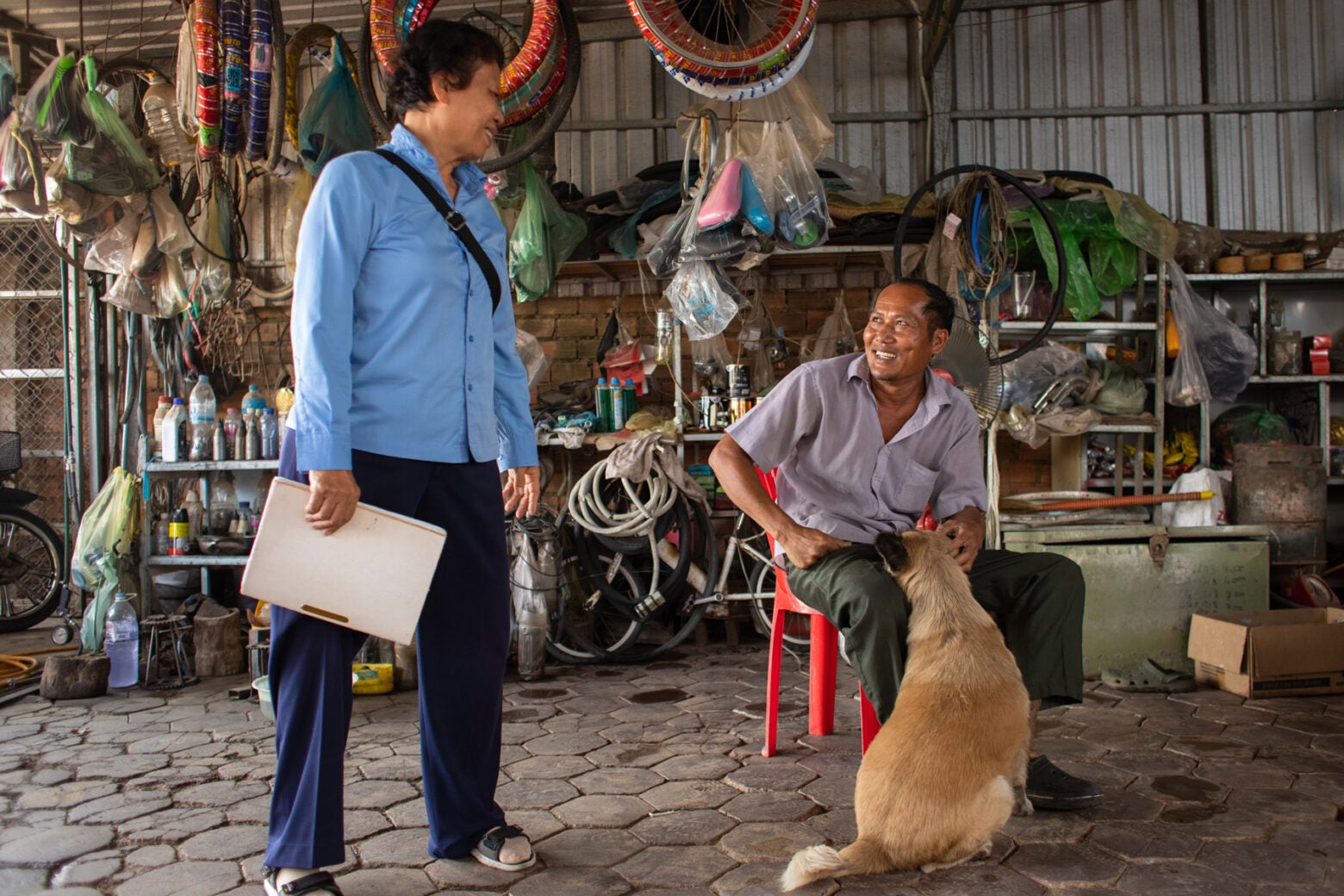
Lim Eng, a community outreach worker with Exceed Worldwide, visits Vi Reth in his house in Kandal province, in southeastern Cambodia, in March. The 53-year-old veteran stepped on a landmine in 1994.
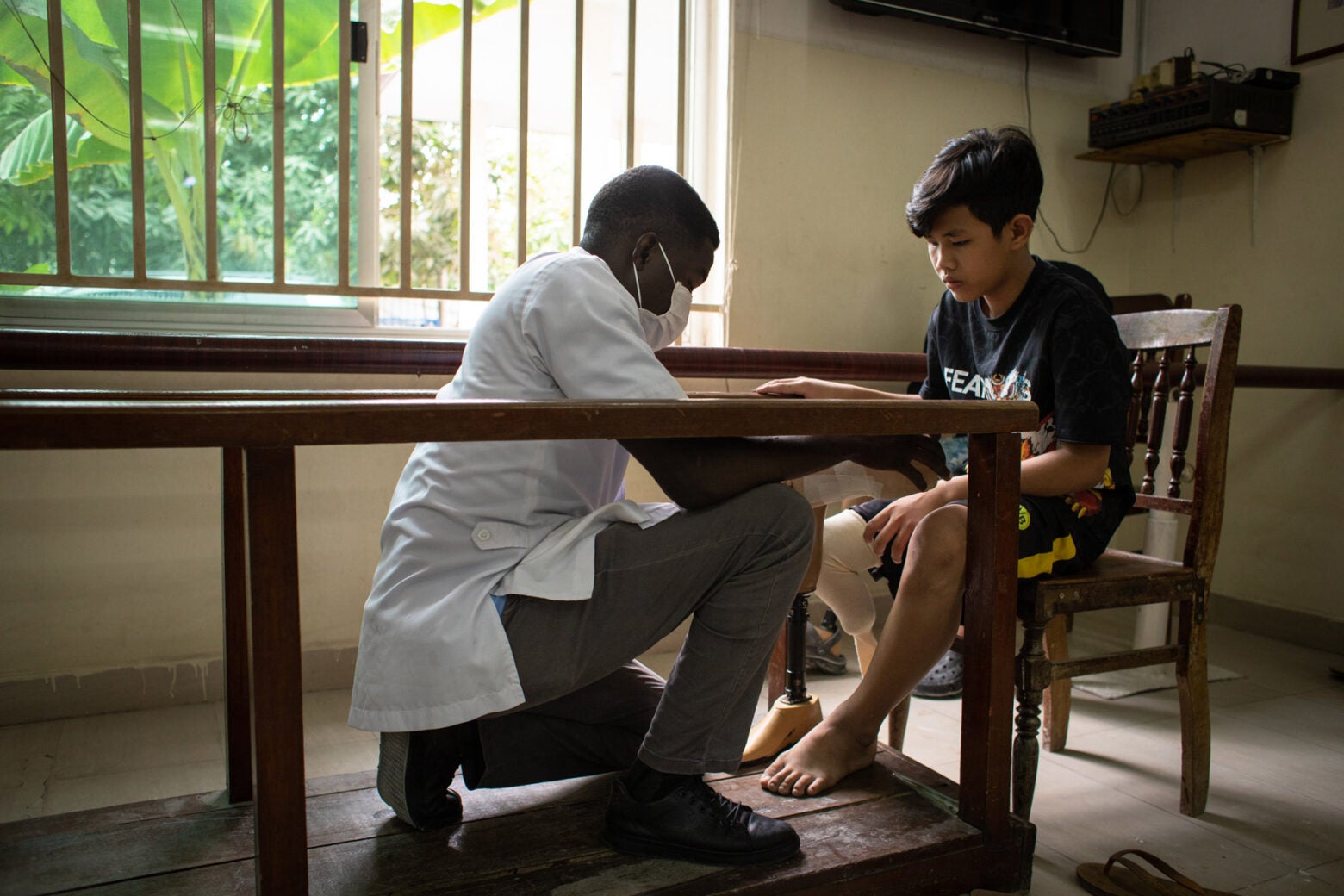
Darak Chour, 14, gets a consultation for a new prosthetic with a South Sudanese clinical placement student, Yohana Victor, at Exceed Worldwide in Phnom Penh. Chour was hit by a truck at age eight.
Observers are cautiously optimistic about shifting services to the Ministry of Health. Some of Cambodia’s other recent reforms have created “pockets of administrative success,” including improvements in maternal health and child death rates, says Mary-Collier Wilks, an assistant professor of sociology at the University of North Carolina Wilmington. “Maybe prosthetics and disability is a new space where we could sort of get the government to actually intervene.”
But Cambodia also has a corruption problem—it is 158th out of 180 in this year’s Transparency International Corruption Perception Index—and whether the new model of prosthetic care succeeds will boil down to money, Wilks says. “It’s going to be about the resources, right? Can you get those resources from the Cambodian government? Can you tax corporations? Can you gather [resources] from your own country versus trying to get them from the UN or the WHO and all of the bilateral donor agencies?”
Even long-time government skeptic Sophal Ear, who escaped the infamous Killing Fields with his mother and brothers in 1976, thinks the Ministry of Health could succeed—with the right commitments. Ear, a political scientist and associate professor at the Thunderbird School of Global Management at Arizona State University, says if Cambodia continues to make long-term investments in health care and limits corruption, “the quality of life for people with disabilities could significantly improve.”
Neither MoSVY nor the Ministry of Health responded to requests for comment about the transition in services.
Cambodia hopes to be mine-free by the end of 2025, but there are still regular discoveries of unexploded ordnance. Last August, a rural school was temporarily closed after staff clearing land for a garden found 2,000 explosives—including 1,000 grenades. And in October, a 500-pound aerial bomb was removed from a Phnom Penh suburb after being buried for more than 50 years.
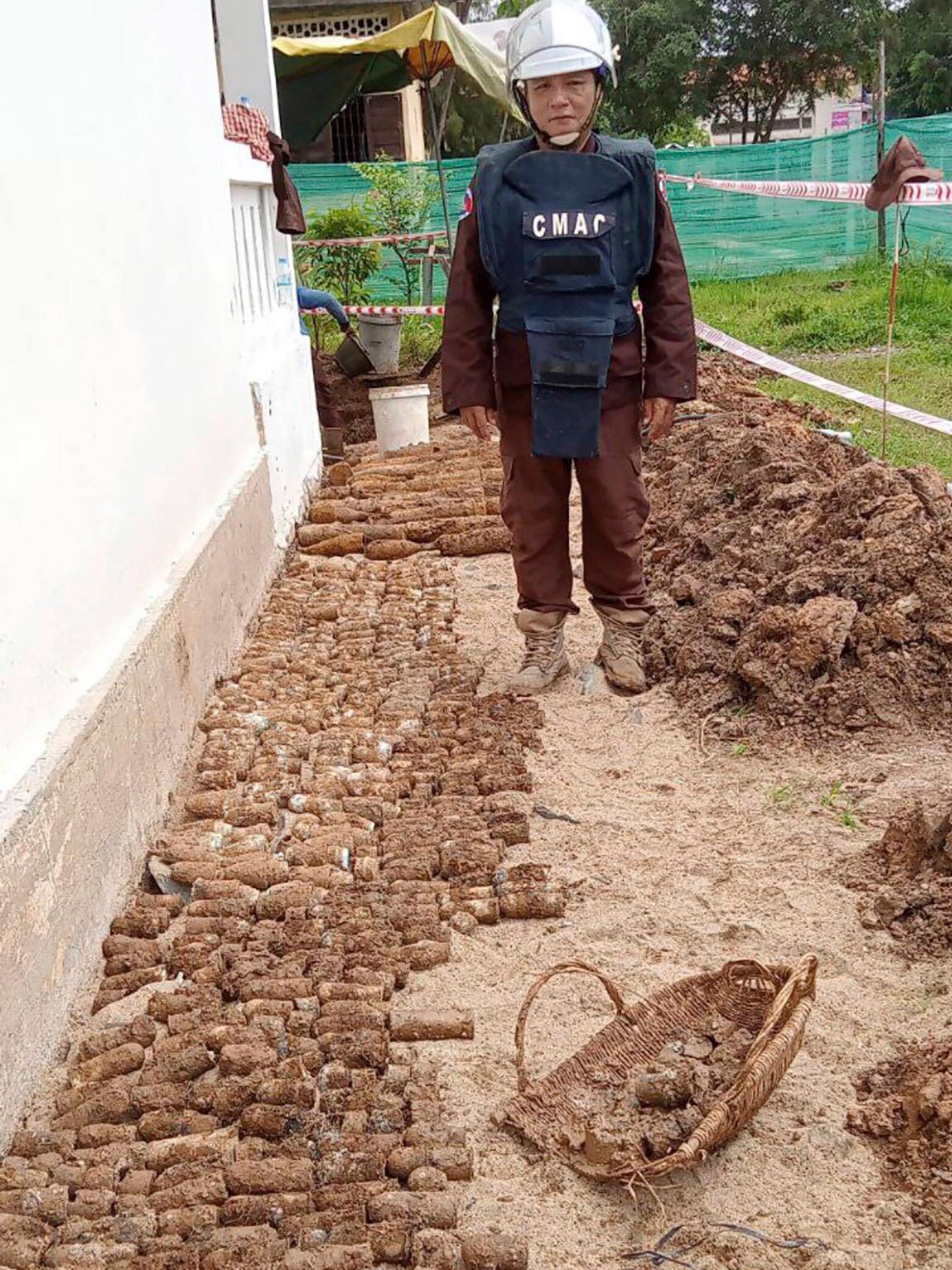
A demining expert stands near some of the thousands of pieces of unexploded ordnance found at a high school in Kratie, a province northeast of Phnom Penh, in August 2023.
Photo: Cambodia Mine Action Center via AP
As ordnance has been cleared, casualty rates have also declined significantly, from 4,000 in 1996 to just 32 in 2023. But the country faces a massive and ongoing public health bill to care for survivors. Since 1979, around 65,000 have been killed or injured by stepping on a mine or encountering explosive ordnance. Of those, just over 9,000 have required an amputation.
For Kheng, who has worked in prosthetics since she was a teenager, this is a moment Cambodia could seize. Experience suggests to her that it’s still a long road, one that needs everyone—from the highest levels of the government down to local implementers, and everyone in between—to share “the willingness, commitment, ownership, and financial responsibility” it will take to get there.
Top image: Lim Eng, a community outreach worker with Exceed Worldwide, reviews material with Vi Reth, who was injured by a landmine in 1994.
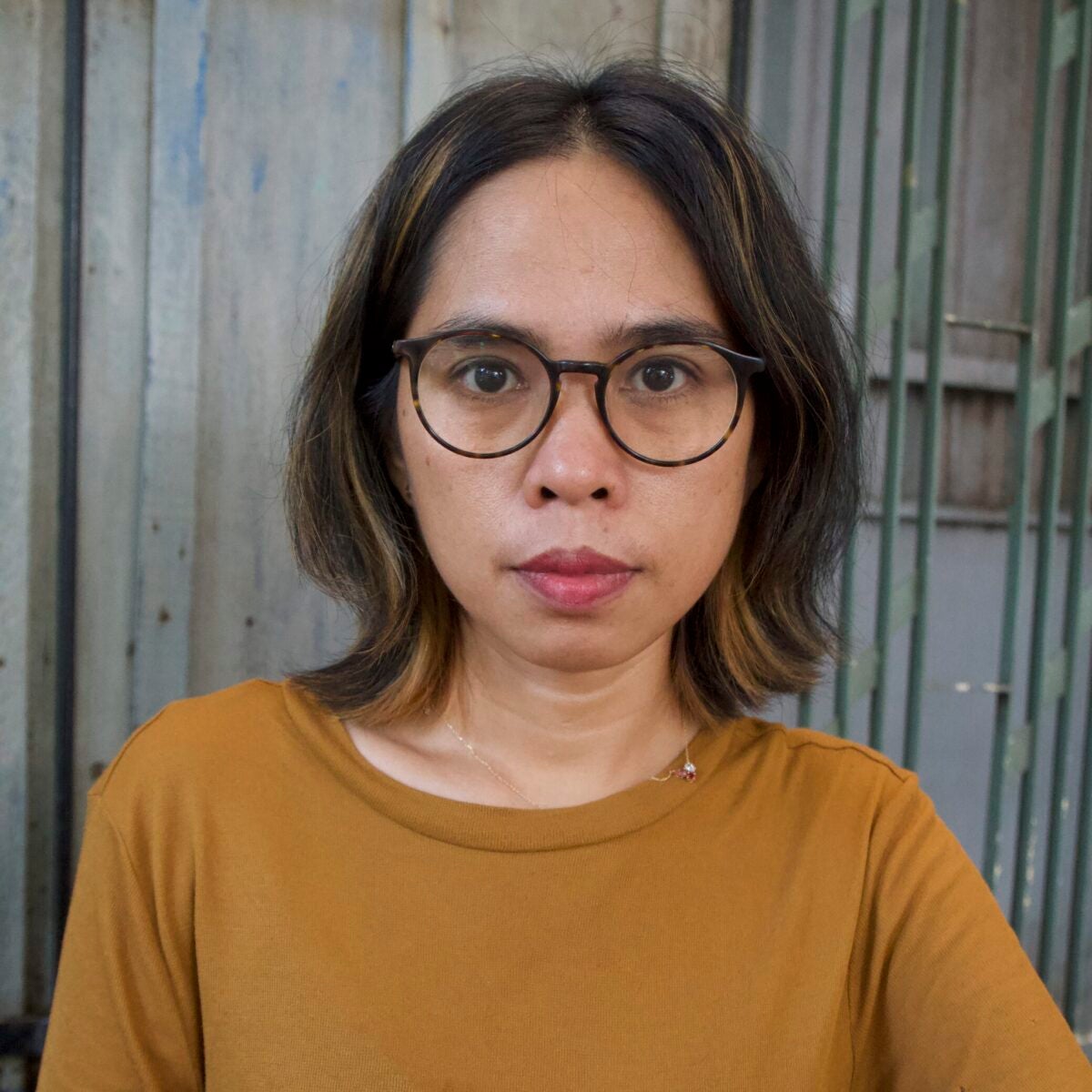
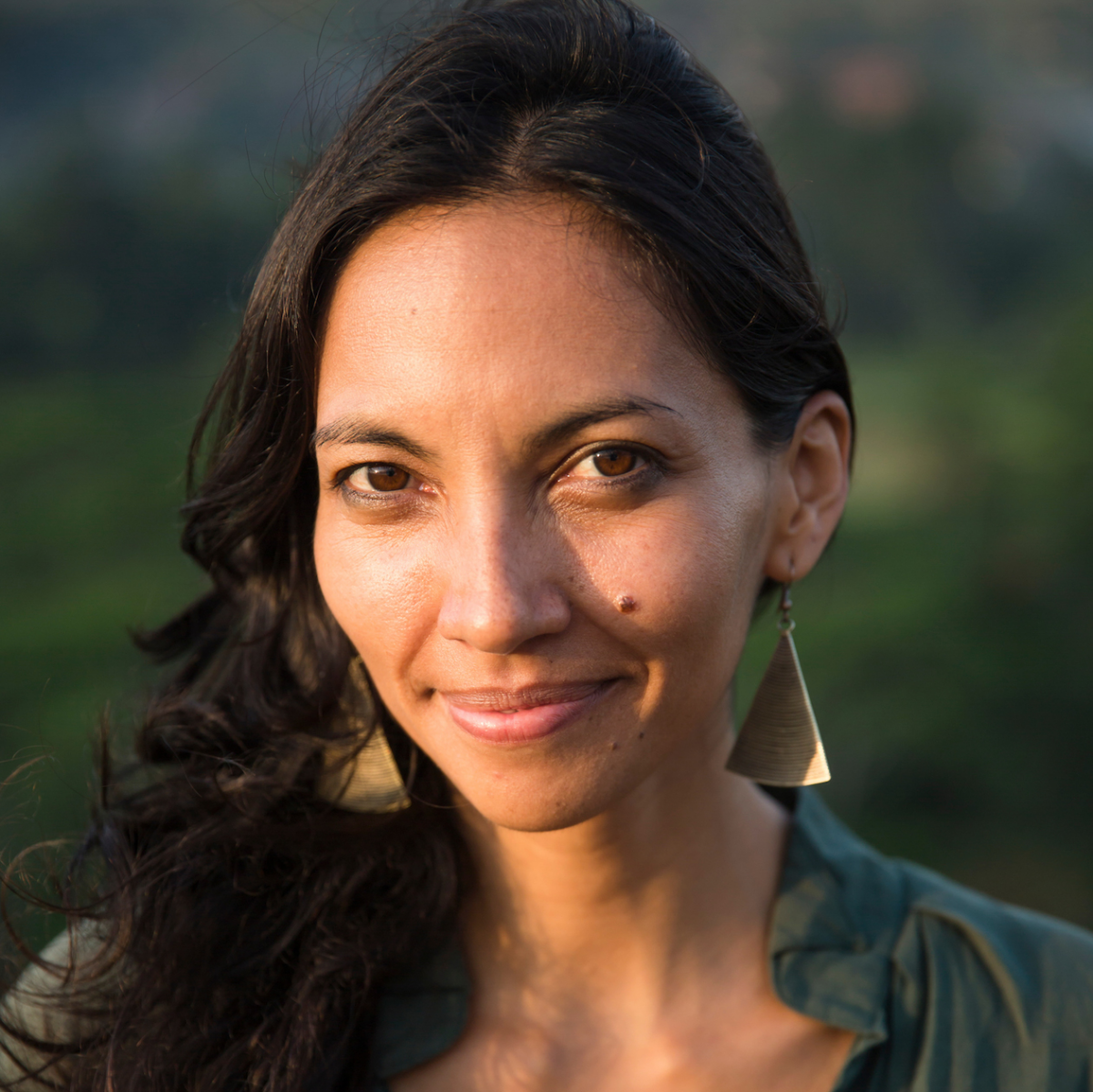
Republish this article
<p>As donor aid lags, the country aims to take over rehabilitation services.</p>
<p>Written by Bopha Phorn</p>
<p>This <a rel="canonical" href="https://harvardpublichealth.org/global-health/as-cambodia-landmines-aid-dries-up-a-new-approach-is-proposed/">article</a> originally appeared in<a href="https://harvardpublichealth.org/">Harvard Public Health magazine</a>. Subscribe to their <a href="https://harvardpublichealth.org/subscribe/">newsletter</a>.</p>
<p class="has-drop-cap">As a girl growing up near Phnom Penh, Sisary Kheng wanted to be a pediatrician, but her family couldn’t afford to send her to medical school. She became a prosthetist instead, an important role in Cambodia, which in the mid-1990s had millions of landmines, unexploded bombs, and other munitions strewn across its countryside. Now, she is playing a central role in Cambodia’s latest effort to stand on its own when it comes to providing care for victims of unexploded ordnance.</p>
<p>“We cannot rely on international aid anymore,” says Kheng, 44, Cambodia country director of Exceed Worldwide, an NGO that provides prosthetics and rehabilitation services. “Government ownership of the process and its success is very important.”</p>
<p>In 1996, when Kheng started her training, prosthetics and rehabilitation for survivors had been paid for and provided almost exclusively by NGOs for nearly 15 years. She’s working on a doctorate developing models for how Cambodia can sustainably self-fund the services.</p>
<p>Her work comes at a crucial time for the country, where rehabilitation services could face severe challenges in the next few years if funding models don’t change. Since the 1980s, Cambodia has received hundreds of millions of dollars in support of mine removal from NGOs and international governments. But assistance for victims of landmines often lags behind—and lately, concentrates in very few countries. In 2022, half of all victim assistance support went to just three countries: Afghanistan, Syria, and Yemen. There were 34 other countries with landmine victims; only seven received dedicated help for victims assistance, while in five others, including Cambodia, victims were supported through broader programs.</p>
<p>“It’s getting more and more difficult to chase down donor funds,” says Carson Harte, CEO of Exceed Worldwide Group, which began supplying prosthetics in Cambodia in 1992. (A year later, it started the school in Phnom Penh where Kheng became one of the country’s first female prosthetists.) Exceed only avoided layoffs last year thanks to a “MrBeast” fundraising <a href="https://www.youtube.com/watch?si=U3rQmELungPKhIyk&v=l5PvwYZQtT8&feature=youtu.be" target="_blank" rel="noreferrer noopener">video</a> on YouTube.</p>
<p>Cambodia has tried before to wean its prosthetics services off donor and NGO support. In 2012, its Ministry of Social Affairs, Veterans and Youth Rehabilitation (MoSVY) began providing services to people with disabilities. Based on data reported in a 2022 study by NGOs and the government, obtained by <em>Harvard Public Health</em>, this effort seems to have largely failed.</p>
<p>MoSVY operated five of the country’s 11 physical rehabilitation facilities, with funding from the Persons with Disabilities Foundation. The other six were operated and supported by Exceed, the International Committee of the Red Cross, and Handicap International. The collaborative study found that staff, services, and morale suffered in centers run by MoSVY. It also said international NGOs remain responsible for more than 77 percent of prosthetics or orthoptist services and more than 83 percent of wheelchair services.</p>
<p>The report recommended that prosthetic services be placed under the Ministry of Health and embedded in a nascent universal health care system being developed with the World Health Organization. The Ministry of Health’s financial reforms and improvements in health services were praised in a letter from Yohei Sasakawa, CEO of the Nippon Foundation, a significant funder of landmine relief. He wrote that such a shift “will greatly improve sustainability and staff retention and will reduce costs.”</p>
<p>Under the proposed model, basic care will be covered by public health funds, but higher-end prosthetics would be paid for by patients, with any profits funneled back into subsidizing prosthetic services. Exceed has already been trialing the approach at a clinic attached to its school, which provides advanced artificial limbs.</p>
<p>Kheng says the model would help retain staff and capture money that would otherwise be spent in more advanced countries like Singapore, where patients with means often seek high-end prosthetics. It would also make care more accessible by integrating it into hospitals and clinics. This would help survivors of landmines and unexploded ordnance as well as a growing number of road accident victims and patients with medical conditions like diabetes. “Every dollar you invest in people with disabilities, through rehabilitation you can actually get nine dollars out of your investment because they can do something else,” Kheng says, citing a recent <a href="https://www.internationaldisabilityalliance.org/blog/every-dollar-invested-assistive-technology-there-return-9" target="_blank" rel="noreferrer noopener">estimate</a> from the International Disability Alliance.</p>
<p>That’s certainly been true for Lim Eng. She stepped on a landmine in 1982 while working with a team clearing Pich Nil mountain, in the southwest of the country. She still cries as she describes the experience, and then finding out she would lose the lower part of her right leg. “I wanted to die,” says Eng, who is now 65, speaking in Khmer. But after being treated and relearning how to ride a bicycle, “It made me feel like I could live,” she says.</p>
<p>She now works at Exceed, where she is part of a community development team that works in Phnom Penh and its outskirts, informing people about available services and breaking down the stigma surrounding disabilities.</p>
<p>Observers are cautiously optimistic about shifting services to the Ministry of Health. Some of Cambodia’s other recent reforms have created “pockets of administrative success,” including improvements in maternal health and child death rates, says Mary-Collier Wilks, an assistant professor of sociology at the University of North Carolina Wilmington. “Maybe prosthetics and disability is a new space where we could sort of get the government to actually intervene.”</p>
<p>But Cambodia also has a corruption problem—it is 158<sup>th</sup> out of 180 in this year’s <a href="https://www.transparency.org/en/cpi/2023">Transparency International Corruption </a><a href="https://www.transparency.org/en/cpi/2023" target="_blank" rel="noreferrer noopener">Perception</a><a href="https://www.transparency.org/en/cpi/2023"> Index</a>—and whether the new model of prosthetic care succeeds will boil down to money, Wilks says. “It’s going to be about the resources, right? Can you get those resources from the Cambodian government? Can you tax corporations? Can you gather [resources] from your own country versus trying to get them from the UN or the WHO and all of the bilateral donor agencies?”</p>
<p>Even long-time government skeptic Sophal Ear, who escaped the infamous Killing Fields with his mother and brothers in 1976, thinks the Ministry of Health could succeed—with the right commitments. Ear, a political scientist and associate professor at the Thunderbird School of Global Management at Arizona State University, says if Cambodia continues to make long-term investments in health care and limits corruption, “the quality of life for people with disabilities could significantly improve.”</p>
<p>Neither MoSVY nor the Ministry of Health responded to requests for comment about the transition in services.</p>
<p>Cambodia hopes to be mine-free by the end of 2025, but there are still regular discoveries of unexploded ordnance. Last August, a rural school was temporarily closed after staff clearing land for a garden found 2,000 explosives—including 1,000 grenades. And in October, a 500-pound aerial bomb was removed from a Phnom Penh suburb after being buried for more than 50 years.</p>
<p>As ordnance has been cleared, casualty rates have also declined significantly, from 4,000 in 1996 to just 32 in 2023. But the country faces a massive and ongoing public health bill to care for survivors. Since 1979, around <a href="https://www.undp.org/cambodia/projects/clearing-result-phase-iv-mine-action-human-development" target="_blank" rel="noreferrer noopener">65,000 have been killed or injured</a> by stepping on a mine or encountering explosive ordnance. Of those, just over 9,000 have required an amputation.</p>
<p class=" t-has-endmark t-has-endmark">For Kheng, who has worked in prosthetics since she was a teenager, this is a moment Cambodia could seize. Experience suggests to her that it’s still a long road, one that needs everyone—from the highest levels of the government down to local implementers, and everyone in between—to share “the willingness, commitment, ownership, and financial responsibility” it will take to get there.</p>
<script async src="https://www.googletagmanager.com/gtag/js?id=G-S1L5BS4DJN"></script>
<script>
window.dataLayer = window.dataLayer || [];
if (typeof gtag !== "function") {function gtag(){dataLayer.push(arguments);}}
gtag('js', new Date());
gtag('config', 'G-S1L5BS4DJN');
</script>
Republishing guidelines
We’re happy to know you’re interested in republishing one of our stories. Please follow the guidelines below, adapted from other sites, primarily ProPublica’s Steal Our Stories guidelines (we didn’t steal all of its republishing guidelines, but we stole a lot of them). We also borrowed from Undark and KFF Health News.
Timeframe: Most stories and opinion pieces on our site can be republished within 90 days of posting. An article is available for republishing if our “Republish” button appears next to the story. We follow the Creative Commons noncommercial no-derivatives license.
When republishing a Harvard Public Health story, please follow these rules and use the required acknowledgments:
- Do not edit our stories, except to reflect changes in time (for instance, “last week” may replace “yesterday”), make style updates (we use serial commas; you may choose not to), and location (we spell out state names; you may choose not to).
- Include the author’s byline.
- Include text at the top of the story that says, “This article was originally published by Harvard Public Health. You must link the words “Harvard Public Health” to the story’s original/canonical URL.
- You must preserve the links in our stories, including our newsletter sign-up language and link.
- You must use our analytics tag: a single pixel and a snippet of HTML code that allows us to monitor our story’s traffic on your site. If you utilize our “Republish” link, the code will be automatically appended at the end of the article. It occupies minimal space and will be enclosed within a standard <script> tag.
- You must set the canonical link to the original Harvard Public Health URL or otherwise ensure that canonical tags are properly implemented to indicate that HPH is the original source of the content. For more information about canonical metadata, click here.
Packaging: Feel free to use our headline and deck or to craft your own headlines, subheads, and other material.
Art: You may republish editorial cartoons and photographs on stories with the “Republish” button. For illustrations or articles without the “Republish” button, please reach out to republishing@hsph.harvard.edu.
Exceptions: Stories that do not include a Republish button are either exclusive to us or governed by another collaborative agreement. Please reach out directly to the author, photographer, illustrator, or other named contributor for permission to reprint work that does not include our Republish button. Please do the same for stories published more than 90 days previously. If you have any questions, contact us at republishing@hsph.harvard.edu.
Translations: If you would like to translate our story into another language, please contact us first at republishing@hsph.harvard.edu.
Ads: It’s okay to put our stories on pages with ads, but not ads specifically sold against our stories. You can’t state or imply that donations to your organization support Harvard Public Health.
Responsibilities and restrictions: You have no rights to sell, license, syndicate, or otherwise represent yourself as the authorized owner of our material to any third parties. This means that you cannot actively publish or submit our work for syndication to third-party platforms or apps like Apple News or Google News. Harvard Public Health recognizes that publishers cannot fully control when certain third parties aggregate or crawl content from publishers’ own sites.
You may not republish our material wholesale or automatically; you need to select stories to be republished individually.
You may not use our work to populate a website designed to improve rankings on search engines or solely to gain revenue from network-based advertisements.
Any website on which our stories appear must include a prominent and effective way to contact the editorial team at the publication.
Social media: If your publication shares republished stories on social media, we welcome a tag. We are @PublicHealthMag on X, Threads, and Instagram, and Harvard Public Health magazine on Facebook and LinkedIn.
Questions: If you have other questions, email us at republishing@hsph.harvard.edu.


